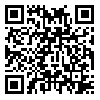Download citation:
BibTeX | RIS | EndNote | Medlars | ProCite | Reference Manager | RefWorks
Send citation to:



BibTeX | RIS | EndNote | Medlars | ProCite | Reference Manager | RefWorks
Send citation to:
Sharifi F, Narouee S, Jahani Y, Haghdoost A A. Examining the Competitiveness of Fields and the Academic Success of Students in Universities of Medical Sciences based on the Results of the Entrance Examination for the Master's Degree. Iranian Journal of Medical Education 2024; 24 :1-10
URL: http://ijme.mui.ac.ir/article-1-5693-en.html
URL: http://ijme.mui.ac.ir/article-1-5693-en.html
Modeling in Health Research Center, Institute for Futures Studies in Health, Kerman University of Medical Sciences, Kerman, Iran. & Kerman University of Medical Sciences , ahaghdoost@gmail.com
Abstract: (1480 Views)
Introduction: The competitiveness of academic fields and the performance of students in admission to universities seem to be the major criteria for assessing the educational situation. This study endeavors to compare the competitiveness of academic fields as well as the performance of students from medical universities in the master's exam.
Methods: In this study, a section of the results of the entrance exam for the Ministry of Health, Treatment, and Medical Education in the academic year 2022 was used. The information included the acceptance rate of students in 42 master's degree fields and from 51 universities of medical sciences. A lower acceptance rate was considered as higher competition, and for comparing the performance of students, the acceptance rate of each university in the master's exam was used, and K-mean clustering analysis was used for grouping competitiveness and performance.
Results: The average acceptance rate in the 42 fields was 26.9%. The competitiveness of fields and the comparison of students' performance from each medical university were examined in four groups, with the highest competition in the first group (Food Microbiology, Medical Imaging Technology, Health Education and Promotion, Operating Room Technology, Biomedical Engineering (Bioelectric and Biomaterials), Toxicology, Pharmaceutical Chemistry, and Cognitive Development) with an average acceptance rate of 8.4%, and the very acceptable performance in admission to the master's level in the first group at Isfahan, Shahid Beheshti, Tabriz, Tehran, and Iran universities of medical sciences with an average acceptance rate of 22.1%.
Conclusion: The results of this study in identifying competitive and non-competitive majors as well as underperformance and outperformance of students at the master's level could be useful for educational decision-makers to improve the educational status and performance of students.
Type of Study: Original research article |
Subject:
other
Received: 2023/09/20 | Accepted: 2024/04/20 | Published: 2024/05/30 | ePublished: 2024/05/30
Received: 2023/09/20 | Accepted: 2024/04/20 | Published: 2024/05/30 | ePublished: 2024/05/30
Send email to the article author
| Rights and permissions | |
 |
This work is licensed under a Creative Commons Attribution-NonCommercial 4.0 International License. |






